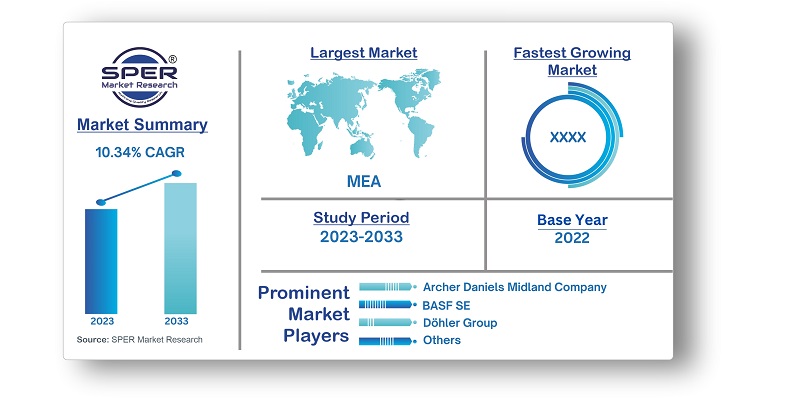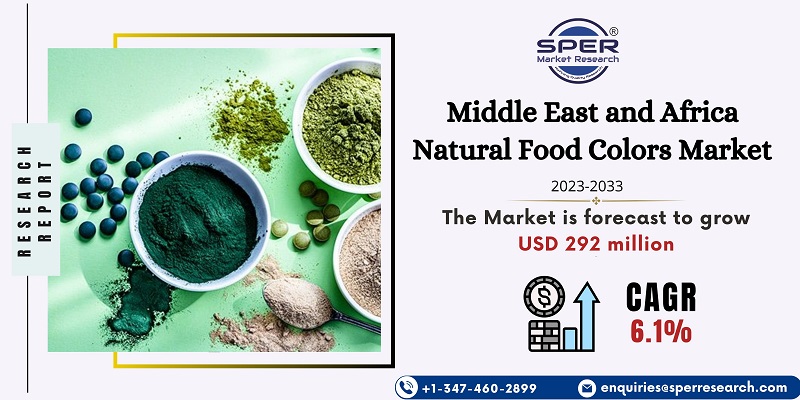
MEA Natural Food Colors Market Growth, Size, Trends, Demand, Revenue, Share and Future Outlook
Middle East and Africa Natural Food Colors Market Size- By Type, By Form, By Application- Regional Outlook, Competitive Strategies and Segment Forecast to 2033
| Published: Dec-2023 | Report ID: FOOD23105 | Pages: 1 - 155 | Formats*: |
| Category : Food & Beverages | |||


| Report Metric | Details |
| Market size available for years | 2019-2033 |
| Base year considered | 2022 |
| Forecast period | 2023-2033 |
| Segments covered | By Type, By Form, By Application |
| Regions covered | Saudi Arabia, South Africa, UAE and rest of MEA |
| Companies Covered | Archer Daniels Midland Company, BASF SE, Döhler Group, DuPont, Givaudan S.A., Koninklijke DSM N.V., Naturex S.A., Oterra A/S, and Sensient Technologies Corporation, Others |
- Bakery and Confectionery Industry
- Brands focusing on premium and unique offerings in the food market.
- Food and Beverage Manufacturers
- Health-Conscious Consumers
- Nutraceutical and Functional Food Producers
- Organic and Natural Food Enthusiasts
- Restaurant and Food Service Providers
- Specialty Food and Gourmet Brands
- Others
| By Type: |
|
| By Form: |
|
| By Application: |
|
- Middle East and Africa Natural Food Colors Market Size (FY’2023-FY’2033)
- Overview of Middle East and Africa Natural Food Colors Market
- Segmentation of Middle East and Africa Natural Food Colors Market By Type (Annatto, Anthocyanins, Caramel, Carmine, Carotenoids, Chlorophyll, Curcumin, Others)
- Segmentation of Middle East and Africa Natural Food Colors Market By Form (Gel, Liquid, Powder)
- Segmentation of Middle East and Africa Natural Food Colors Market By Application (Bakery and Confectionery, Beverages and Sauces, Dairy and Frozen Desserts, Dressings and Condiments, Meat, Poultry and Seafood, RTC and RTE Products, Others)
- Statistical Snap of Middle East and Africa Natural Food Colors Market
- Expansion Analysis of Middle East and Africa Natural Food Colors Market
- Problems and Obstacles in Middle East and Africa Natural Food Colors Market
- Competitive Landscape in the Middle East and Africa Natural Food Colors Market
- Impact of COVID-19 and Demonetization on Middle East and Africa Natural Food Colors Market
- Details on Current Investment in Middle East and Africa Natural Food Colors Market
- Competitive Analysis of Middle East and Africa Natural Food Colors Market
- Prominent Players in the Middle East and Africa Natural Food Colors Market
- SWOT Analysis of Middle East and Africa Natural Food Colors Market
- Middle East and Africa Natural Food Colors Market Future Outlook and Projections (FY’2023-FY’2033)
- Recommendations from Analyst
1.1. Scope of the report1.2. Market segment analysis
2.1. Research data source
2.1.1. Secondary Data2.1.2. Primary Data2.1.3. SPER’s internal database2.1.4. Premium insight from KOL’s
2.2. Market size estimation
2.2.1. Top-down and Bottom-up approach
2.3. Data triangulation
4.1. Driver, Restraint, Opportunity and Challenges analysis
4.1.1. Drivers4.1.2. Restraints4.1.3. Opportunities4.1.4. Challenges
4.2. COVID-19 Impacts of the Middle East and Africa Natural Food Colors Market
5.1. SWOT Analysis
5.1.1. Strengths5.1.2. Weaknesses5.1.3. Opportunities5.1.4. Threats
5.2. PESTEL Analysis
5.2.1. Political Landscape5.2.2. Economic Landscape5.2.3. Social Landscape5.2.4. Technological Landscape5.2.5. Environmental Landscape5.2.6. Legal Landscape
5.3. PORTER’s Five Forces
5.3.1. Bargaining power of suppliers5.3.2. Bargaining power of buyers5.3.3. Threat of Substitute5.3.4. Threat of new entrant5.3.5. Competitive rivalry
5.4. Heat Map Analysis
6.1. Middle East and Africa Natural Food Colors Market Manufacturing Base Distribution, Sales Area, Product Type6.2. Mergers & Acquisitions, Partnerships, Product Launch, and Collaboration in Middle East and Africa Natural Food Colors Market
7.1. Middle East and Africa Natural Food Colors Market Value Share and Forecast, By Type, 2023-20337.2. Annatto7.3. Anthocyanins7.4. Caramel7.5. Carmine7.6. Carotenoids7.7. Chlorophyll7.8. Curcumin7.9. Others
8.1. Middle East and Africa Natural Food Colors Market Value Share and Forecast, By Form, 2023-20338.2. Gel8.3. Liquid8.4. Powder
9.1. Middle East and Africa Natural Food Colors Market Value Share and Forecast, By Application, 2023-20339.2. Bakery and Confectionery9.3. Beverages and Sauces9.4. Dairy and Frozen Desserts9.5. Dressings and Condiments9.6. Meat, Poultry and Seafood9.7. RTC and RTE Products9.8. Others
10.1. Middle East and Africa Natural Food Colors Market Size and Market Share
11.1. Middle East and Africa Natural Food Colors Market Size and Market Share By Type (2019-2026)11.2. Middle East and Africa Natural Food Colors Market Size and Market Share By Type (2027-2033)
12.1. Middle East and Africa Natural Food Colors Market Size and Market Share By Form (2019-2026)12.2. Middle East and Africa Natural Food Colors Market Size and Market Share By Form (2027-2033)
13.1. Middle East and Africa Natural Food Colors Market Size and Market Share By Application (2019-2026)13.2. Middle East and Africa Natural Food Colors Market Size and Market Share By Application (2027-2033)
14.1. Middle East and Africa Natural Food Colors Market Size and Market Share By Region (2019-2026)14.2. Middle East and Africa Natural Food Colors Market Size and Market Share By Region (2027-2033)14.3. Saudi Arabia14.4. South Africa14.5. UAE14.6. Rest of MEA
15.1. Archer Daniels Midland Company
15.1.1. Company details15.1.2. Financial outlook15.1.3. Product summary15.1.4. Recent developments
15.2. BASF SE
15.2.1. Company details15.2.2. Financial outlook15.2.3. Product summary15.2.4. Recent developments
15.3. Döhler Group
15.3.1. Company details15.3.2. Financial outlook15.3.3. Product summary15.3.4. Recent developments
15.4. DuPont
15.4.1. Company details15.4.2. Financial outlook15.4.3. Product summary15.4.4. Recent developments
15.5. Givaudan S.A.
15.5.1. Company details15.5.2. Financial outlook15.5.3. Product summary15.5.4. Recent developments
15.6. Koninklijke DSM N.V.
15.6.1. Company details15.6.2. Financial outlook15.6.3. Product summary15.6.4. Recent developments
15.7. Naturex S.A.
15.7.1. Company details15.7.2. Financial outlook15.7.3. Product summary15.7.4. Recent developments
15.8. Oterra A/S
15.8.1. Company details15.8.2. Financial outlook15.8.3. Product summary15.8.4. Recent developments
15.9. Sensient Technologies Corporation
15.9.1. Company details15.9.2. Financial outlook15.9.3. Product summary15.9.4. Recent developments
15.10. Others
SPER Market Research’s methodology uses great emphasis on primary research to ensure that the market intelligence insights are up to date, reliable and accurate. Primary interviews are done with players involved in each phase of a supply chain to analyze the market forecasting. The secondary research method is used to help you fully understand how the future markets and the spending patterns look likes.
The report is based on in-depth qualitative and quantitative analysis of the Product Market. The quantitative analysis involves the application of various projection and sampling techniques. The qualitative analysis involves primary interviews, surveys, and vendor briefings. The data gathered as a result of these processes are validated through experts opinion. Our research methodology entails an ideal mixture of primary and secondary initiatives.



Frequently Asked Questions About This Report
PLACE AN ORDER
Year End Discount
Sample Report
Pre-Purchase Inquiry
NEED CUSTOMIZATION?
Request CustomizationCALL OR EMAIL US
100% Secure Payment






Related Reports
Our Global Clients
Our data-driven insights have influenced the strategy of 200+ reputed companies across the globe.






















